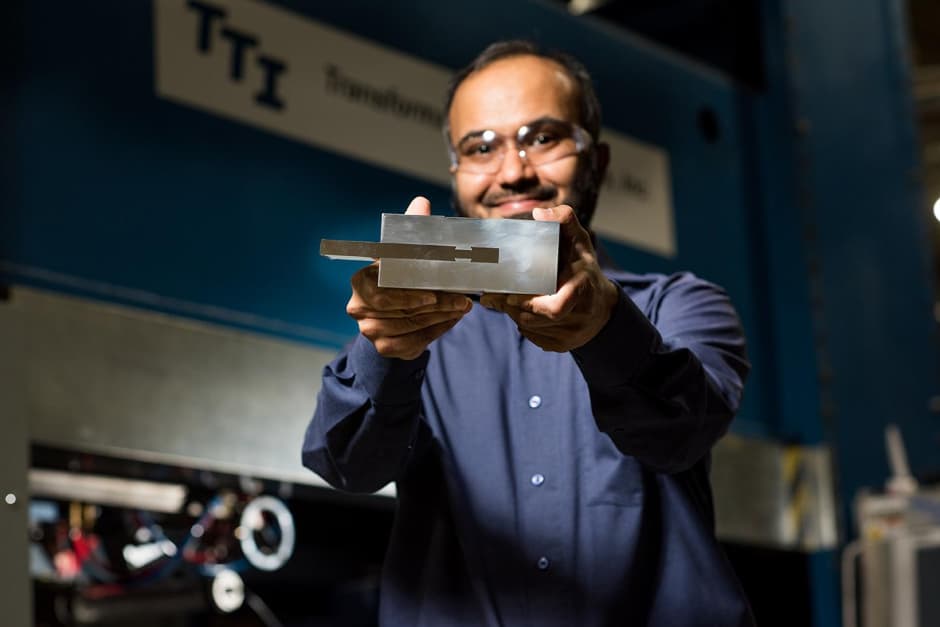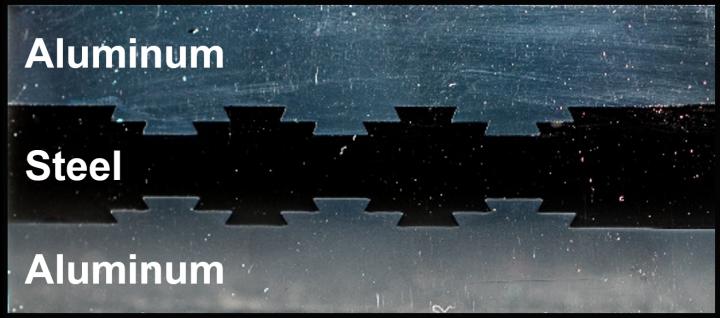A process for joining thick plates of aluminium to steel could to lead to lighter-weight military vehicles that are more agile and fuel efficient.

The process – dubbed Friction Stir Dovetailing – was developed by researchers at Pacific Northwest National Laboratory and is described in Scripta Materialia.
According to the US Government Accountability Office, the military spends several billion dollars each year on fuel consumption. To lower fuel costs and increase operational effectiveness the US Army Tank Automotive Research Development and Engineering Center (TARDEC) launched a campaign in 2014 seeking ways to make combat systems more lightweight. One approach looked at the replacement of heavy steel components with thicker aluminium, which cannot be welded to steel due to the vastly different melting points of the two metals.
In a bid to overcome this hurdle, TARDEC teamed up with PNNL to develop Friction Stir Dovetailing. Previous techniques had included Friction Stir Welding to join similar metals of differing thickness, and Friction Stir Scribe, which joins thin sheets of different materials, like aluminium and steel.
Friction Stir Scribe solved the challenge of joining thin sheets of aluminium with steel, but the technique did not scale up to the thick plates of aluminium needed for military vehicles.
For Friction Stir Dovetailing, a specially designed tool deforms the aluminium into a steel dovetail groove to form a mechanical interlock. The tool simultaneously rubs along the bottom of the dovetail to form a thin metallurgical bond - or intermetallic compound - which binds the metals together within the dovetail.
https://www.youtube.com/watch?v=X5JzOt3cozY
"The combination of mechanical interlocking and metallurgical bonding formed during a single process is the innovation that produces joints of superior strength and ductility compared to joints created by the other friction stir methods," said PNNL engineer Scott Whalen, who led the research.
The research team found that the growth of intermetallic compounds could be inhibited via the use of complex machine controls, which regulate temperature and pressure at the aluminium-steel interface.
These compounds grow thick and non-uniformly during the other friction stir techniques, causing joint brittleness and failure. However, growth of intermetallic compounds - iron aluminide - during the Friction Stir Dovetailing technique is beneficial to the joint because they are so thin - one thousand times thinner than a human hair - which acts as an adhesive without causing embrittlement.

"Intermetallic compounds will form between aluminium and steel during all friction stir techniques as part of the heating process," said Whalen. "We discovered that Friction Stir Dovetailing inhibits intermetallic compound overgrowth because temperature and pressure are much lower than other friction stir approaches."
Lab testing of joints made by Friction Stir Dovetailing showed that when combining metallurgical bonding with the dovetail configuration, the joint strength is not only superior, but the material can stretch to over a half centimetre before the joint breaks.
The research team now plans to refine the technique and expand the process for other joint configurations. In addition to aluminium and steel, other material combinations such as aluminium to copper, aluminium to magnesium, and magnesium to steel can also be joined using Friction Stir Dovetailing.




Nanogenerator consumes CO2 to generate electricity
Nice to see my my views being backed up by no less a figure than Sabine Hossenfelder https://youtu.be/QoJzs4fA4fo